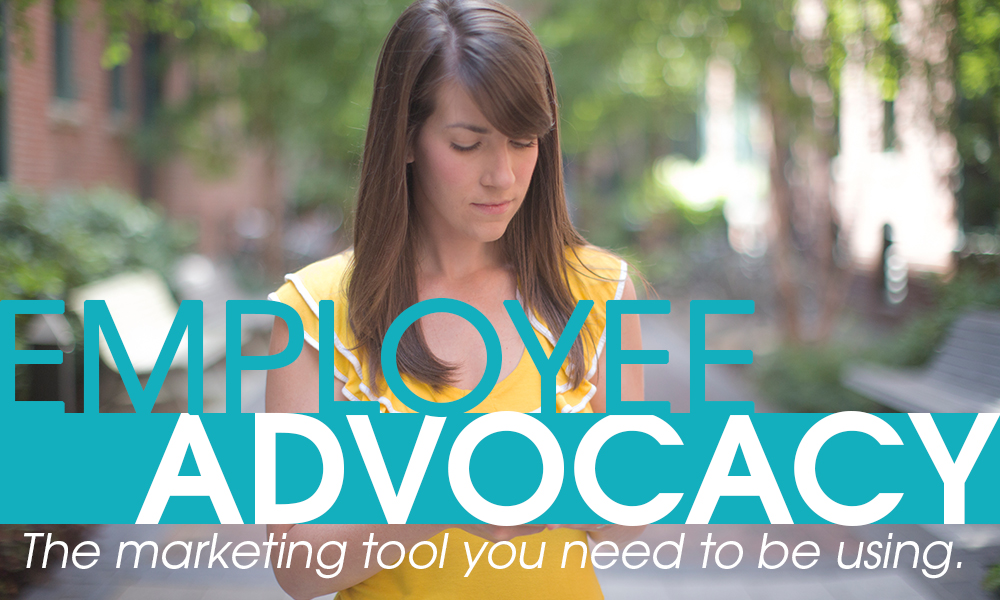Employee Advocacy: The Marketing Tool You’re Not Using, But Should Be
Date: June 20, 2016Category: Author: Heather

The marketing tool you’re not using but should be.
Shortly before her departure from a previous employer of mine, a friend of mine shared a news story about the organization accompanied by a negative—and incorrect—comment. Not important to the story, but her departure wasn’t as a result of the comment.
I badly wanted to correct her.
Not to argue. Not because I agreed. Nor because I disagreed. But, because, if she wanted to attack the company—rightly or wrongly—she should use correct facts.
What stopped me?
Despite being a member of the communications team, I wasn’t allowed to. There are about a hundred reasons why only official spokespersons could speak on behalf of this particular company—most importantly because it operated in a highly regulated industry—and I completely understood every one of them.
I was frustrated because this former employee should have followed the same rules about not speaking publicly as I did. We’d had the same training. We were bound by the same employee handbook. But she didn’t care.
What’s the moral of this absurdly long-winded story?
Whether or not you have an official policy banning employees from talking about your company, 50 percent of them are posting messages, pictures and videos that mention your practice anyway.
So, what do you do?
Turn your employees into advocates.
Research shows that patients trust the opinions of people they know—colleagues, friends, family members, even a casual acquaintance—when looking for a dental practice.
Your employees are connected to ten times more people than your practice. Leverage these connections by encouraging your employees to interact with your content. When employees tell your story; or react to, comment on or share your posts, your content appears in the news feeds of their friends and family.
An employee advocate—or ambassador—encourages interaction with your content, strengthens your relationship with current and potential patients, and provides a direct channel of communication with the practice.
Building a successful employee advocacy program for your practice.

Creating an employee advocacy program could be the biggest marketing win you have this year.
Create a social media policy
Your social media policy plays a vital role in the success of your program.
Empower employees to be creative and to share your content by providing guidelines for appropriate behavior online. Try adding these tips to your policy:
1. Engage, engage, engage
We’ve created content that’s entertaining, inspiring, educational and—most importantly—shareable. Pass it along. You know the content is approved because we posted it.
2. Keep it real
Always be authentic, users can tell when you’re spinning a tale for entertainment value.
3. Do your job
We’re stoked that you’ve joined our social media efforts, but not at the cost of patient care. Your patient’s needs always come first.
4. Think before you post
Often gaffes on social media could have been avoided if the poster had slowed down. Think, is this content that lives up to the standards of our brand? Would I want my Mom to see my name associated with this? Are the technical elements of the post correct (e.g., Am I posting from the correct account? Is the spelling and grammar correct?)
5. Protect our patients
HIPAA violations are no joke. But more importantly, it’s the right thing to do. Don’t disclose patient information in a post. Check the background of photos for patients or photos of patients.
6. Love our brand
Lululemon employees may be the best example of this. They love nothing more than talking about the yoga clothing retailer, even using the hashtag #lululemonambassador.

Lululemon employees share everything about their Lulu lifestyle–at work and at play.
PS, we love you too.
7. Respect sensitive information
We trust you. That’s why we shared with you that we’re thinking of partnering with a dentist who may retire soon. And, our quarterly earnings. And that we’re gearing up for a hiring frenzy.
We expect you to keep that to yourself. Tradecraft Baby.
8. Keep a lid on it
If you have a sibling, this concept is familiar to you. It’s okay to argue with each other, but if anyone else says something mean about them, it’s a problem. Same here. If you have a disagreement with management or a colleague, it stays in-house. We don’t throw our own under-the-bus in public.
A good social media policy delegates responsibilities and designate what roles each administrator plays, while defining consequences for violating the policy (e.g., written up or automatic termination).
Using the information in this infographic, we have no doubt you’ll launch an employee advocacy program that amplifies your practice’s voice.

Hey Heather! Great article on employee advocacy! It really has become the new necessity for implementing an efficient content marketing strategy, and it’s a great way to increase employee involvement with the company. What are your thoughts on using an employee advocacy platform like DrumUp? I think it greatly minimizes the time and effort required in the execution of the program through scheduling and automation.